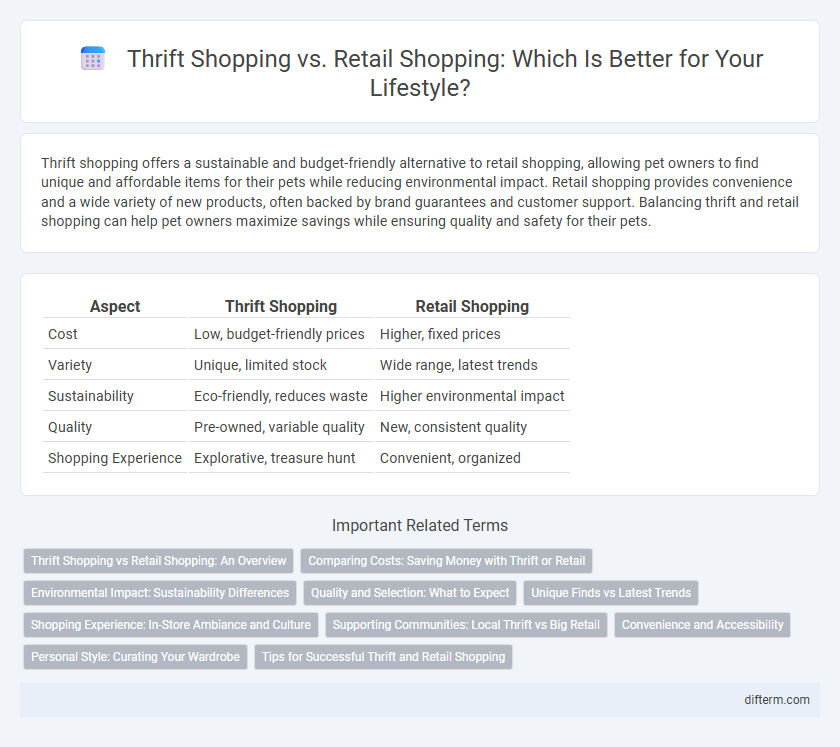Thrift shopping offers a sustainable and budget-friendly alternative to retail shopping, allowing pet owners to find unique and affordable items for their pets while reducing environmental impact. Retail shopping provides convenience and a wide variety of new products, often backed by brand guarantees and customer support. Balancing thrift and retail shopping can help pet owners maximize savings while ensuring quality and safety for their pets.
Table of Comparison
| Aspect | Thrift Shopping | Retail Shopping |
|---|---|---|
| Cost | Low, budget-friendly prices | Higher, fixed prices |
| Variety | Unique, limited stock | Wide range, latest trends |
| Sustainability | Eco-friendly, reduces waste | Higher environmental impact |
| Quality | Pre-owned, variable quality | New, consistent quality |
| Shopping Experience | Explorative, treasure hunt | Convenient, organized |
Thrift Shopping vs Retail Shopping: An Overview
Thrift shopping offers unique sustainability benefits by promoting recycling and reducing waste, which contrasts with retail shopping's reliance on fast fashion and mass production. Consumers often find thrift stores more budget-friendly while accessing one-of-a-kind vintage items that retail stores rarely carry. This distinct approach fosters eco-conscious choices and supports local communities, making thrift shopping an appealing alternative to traditional retail experiences.
Comparing Costs: Saving Money with Thrift or Retail
Thrift shopping offers significant cost savings by providing gently used items at a fraction of retail prices, often 50-90% cheaper than new products. Retail shopping, while generally more expensive, guarantees brand new quality and warranties that thrift stores usually do not provide. Consumers seeking budget-friendly options benefit most from thrift stores, especially for clothing, home decor, and books, while retail remains preferable for specific, high-demand new items.
Environmental Impact: Sustainability Differences
Thrift shopping significantly reduces waste by reusing clothing and lowering the demand for new production, which in turn decreases carbon emissions and water consumption associated with textile manufacturing. Retail shopping typically involves higher environmental costs due to fast fashion's reliance on resource-intensive processes and synthetic materials that contribute to pollution and landfill buildup. Choosing thrift options promotes a circular economy and supports sustainability by extending the lifecycle of garments and minimizing the environmental footprint of consumer habits.
Quality and Selection: What to Expect
Thrift shopping offers unique, often high-quality items with a diverse selection that reflects past trends and rare finds, appealing to those seeking individuality and sustainability. Retail shopping guarantees consistent quality standards and a broad, current selection of new products, ensuring customers access the latest styles and reliable durability. Expect thrift stores to provide eclectic, one-of-a-kind pieces, while retail outlets deliver predictable quality and abundant variety.
Unique Finds vs Latest Trends
Thrift shopping offers unique finds that often carry a story and timeless appeal, appealing to those seeking individuality and sustainable choices. Retail shopping emphasizes the latest trends, providing new styles that reflect current fashion movements and seasonal collections. Choosing between thrift and retail depends on whether one values originality and eco-consciousness or staying up-to-date with contemporary fashion.
Shopping Experience: In-Store Ambiance and Culture
Thrift shopping offers a unique in-store ambiance characterized by nostalgic, eclectic displays that encourage treasure hunting, fostering a culture of sustainability and individuality. Retail shopping environments prioritize sleek design, brand consistency, and convenience, creating a polished atmosphere aimed at efficiency and trend-focused purchases. The cultural contrast highlights thrift stores as community-driven hubs with stories behind each item, whereas retail shops emphasize brand identity and streamlined consumer experiences.
Supporting Communities: Local Thrift vs Big Retail
Shopping at local thrift stores reinvests money directly into community programs and supports small business owners, fostering local economic growth and job creation. In contrast, big retail chains often funnel profits to distant headquarters, limiting direct benefits to the community. Choosing thrift shopping promotes sustainability and community resilience by reducing waste and encouraging social inclusivity.
Convenience and Accessibility
Thrift shopping offers unique convenience through affordable pricing and diverse, one-of-a-kind finds ideal for budget-conscious consumers. Retail shopping provides unparalleled accessibility with widespread store locations and seamless online platforms, catering to quick purchases and immediate product availability. Both methods serve distinct consumer needs by balancing cost-effectiveness against ease of access.
Personal Style: Curating Your Wardrobe
Thrift shopping offers a unique opportunity to curate a personalized wardrobe by discovering one-of-a-kind pieces that reflect individual style and creativity, unlike retail shopping which often features mass-produced items. Embracing thrift allows for the integration of vintage, sustainable, and budget-friendly finds that add distinct character and authenticity to a wardrobe. Personal style evolves through thoughtful selection, making thrift shopping a valuable approach for cultivating a diverse and meaningful clothing collection.
Tips for Successful Thrift and Retail Shopping
Maximize savings by creating a flexible shopping list tailored for thrift stores, prioritizing quality over brand names to discover unique, durable items. When retail shopping, monitor seasonal sales and use loyalty programs to access discounts and accumulate rewards, enhancing overall value. Combine both strategies by inspecting items carefully for condition and fit, ensuring every purchase meets personal style and practical needs.
thrift shopping vs retail shopping Infographic

 difterm.com
difterm.com